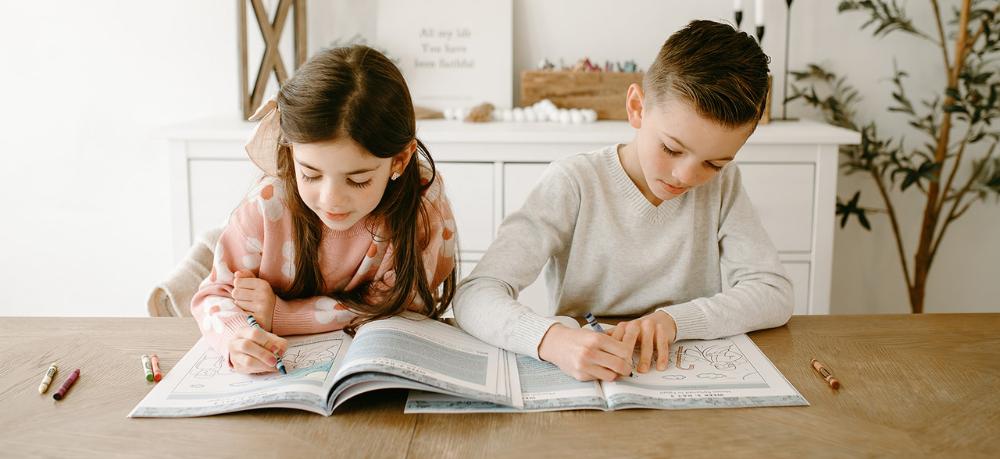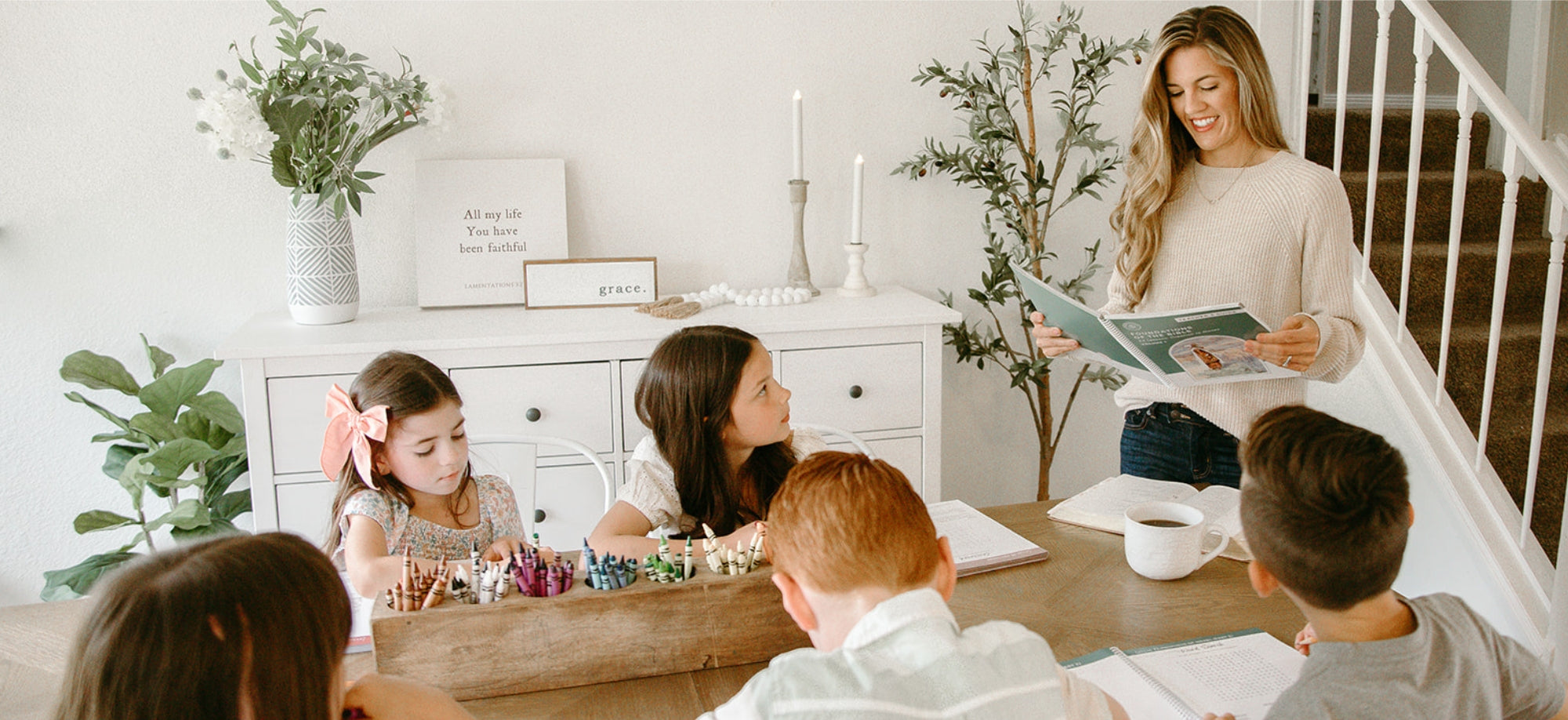10 Tips For First-Time Essentials Parents

We just completed our first year of Essentials (2024-2025) with Classical Conversations (the writing and grammar program for 4th–6th graders), and today I’m excited to share the tips and tricks that made our year enjoyable, manageable, and even fun!
I know Essentials can feel intimidating and overwhelming at first, but my hope is that by the end of this post, you’ll feel encouraged and equipped as you head into your first year. So, let’s dive in!
1. Practice What’s Being Taught in Class (Yes—You, the Parent)
This is my top tip because it will help you be successful for the remainder of the year. Go into the school year with the mindset of being a student. The most overwhelming part can be all the new grammar and language thrown at you, and then not knowing how to teach it at home. You need to remember that the Essentials tutor is primarily there to teach you (the parent). If you aren't engaged during class time, you and your student will struggle to get the most out of it at home. I suggest sitting next to your student, taking notes, asking questions, parsing the sentences yourself, and being a lead learner. I promise that if you try to learn the material yourself, you’ll be much better equipped and willing to review at home.
2. Read Your Essentials Guide Before Class
Everything the tutor is going to teach in class comes straight from the Essentials guide. If you pre-read the lesson before class, you’ll understand what new grammar concepts will be introduced and follow along easier. Even just skimming over it during your lunch break can be super helpful.
3. Download the "Essentials in an Hour a Day" Bookmark
This helpful bookmark is found on CC Connected—this LINK will take you directly to it once you are logged in to CC Connected. It breaks down how to review all the Essentials material in just one hour a day. We basically stuck with this all year, and my next tip #4 will make this easy to do.
- Review Charts—10 min/day
- Do the Analytical Task Sheet (sentence parsing and diagramming)—10-15 min/day
- Editing Exercises—5 min/day
- Spelling—10 min/day (Since we use All About Spelling, I skip the spelling portion in the Essentials guide)
- Writing—15-20 min/day
- Vocabulary—5 min/day
4. Use Kimberly Vieley's Essentials Workbook.
This was the most helpful resource I used throughout the year. Kim is a dear friend of mine and is one of the Essentials tutors for our community. She made this resource for our community and graciously shares it with others. Download Here.
This workbook gathers all the information you need to review each day and puts it into one open-and-go format. It was a total game changer—I truly can’t imagine doing Essentials without it. This is a free resource that takes an incredible amount of time and energy to create, so if you use it, please consider donating.
Before she created this, you could find similar worksheets on CC Connected's Onward e-zine, but this one is much more user-friendly (and prettier, too!).
Note: If you use her workbook, this will help you complete all the tasks on the “Essentials in an hour a day” bookmark except for the writing portion :)
5. Follow the Easy + 1 Rule
If you watch any of the Andrew Pudewa videos with your group (ours had monthly viewing nights), you’ll hear about the Easy + 1 method. This approach encourages you to let your child master a concept before introducing a new one. Wait until the current concept feels easy—then add one new concept.
It’s essential (pun intended) to remember that they do not need to master everything in their first year. They’ll repeat the exact same concepts (just with different history-based writing lessons) for two more years.
6. You CAN'T Help Your Child Too Much
This was so important for me to remember each day, especially when tackling Key Word Outlines. You’ll quickly overwhelm a first-time Essentials student if you expect them to read the text, choose the key words, and write it all down by themselves. I strongly recommend writing the KWO for them and simply letting them dictate what they think the key words should be. I often gave suggestions, especially when they tried to use unimportant words like “the,” “for,” etc. When it's time to write the paragraphs, let them dictate complete sentences from their KWO. It truly is a team effort, and you will be amazed at how much you learn!
Last year, I wrote every Key Word Outline. My child dictated to me (with lots of guided prep at the beginning), and I modeled what a good Key Word Outline looks like, which was new for me too! He also dictated his paragraphs while I typed them out. It worked really well that way.
7. Practice Parsing and Diagramming a Sentence Daily
I always start with the recommended sentence from the Essentials guide so I can follow the prompt word for word. Remember the Easy + 1 rule. If the weekly sentences become too complicated for you and your student, just keep reviewing the earlier sentence structures. You can gradually build when the simple sentences become easy.
Tip: Once I became more comfortable, I started switching things up by swapping out nouns, adjectives, and verbs to create sentences my child would enjoy. I made them sports-related for my son since that’s his passion. He was still getting the necessary practice, just with topics he found more fun and engaging.
For example, if the sentence said, “The volcano erupted,” I might also try, “The cat purred,” or “The goalie jumped.” By swapping out the nouns and verbs, we could keep practicing the same sentence pattern (S-Vi) until it felt easy.
8. Memorize Chart A
There are many charts in Essentials, but Chart A is the most important one to memorize in Year 1. You'll use it every day in Essentials, so it’s the best place to start. We encouraged our kids to memorize it and celebrated with a treat like a smoothie or ice cream once they did. A lot of students were overachievers and had it memorized by the end of the first week. The sooner you memorize it, the better!
9. Create a Quarterly Essentials Binder
This can be confusing to explain via text, so watch this reel I made to walk you through it!
Basically, I have 3 Binders:
1. Essentials Guide
2. Solutions manual
3. Quarterly binder (6 weeks from each of the above binders). I update this each quarter so I don't have to carry around so much stuff. I bring my quarterly binder to class.
What my quarterly binder includes:
- All the charts from the Solutions Guide
- 6 weeks of the current quarter's weekly sentences from the Solutions Guide
- Introduction and Scope & Sequence from the Essentials Guide
- 6 weeks of the current quarter's curriculum from the Essentials Guide (pre-read these before class, tip #2)
- Lined paper to take notes, practice sentence parsing, and diagramming in class
- On the cover: the Essentials in 1 Hour A Day Bookmark (tip #3)
Note: I didn’t use the paragraph editing exercises during our first year, so I stopped including those in my binder after the first quarter. I may use them more as we progress and repeat cycles, but the main thing I focused on was the weekly Essentials sentences. Those were super helpful! I just read the exact prompts from the guide as we parsed the sentences together. Repetition really is key.
10. Follow the Weekly Writing Schedule
This is written out on the "Essentials in an Hour a Day" Bookmark and is extremely helpful! We completed each weekly assignment in small, manageable steps:
-
Day 1: Community day — learn the new material
-
Day 2: Write a Key Word Outline (KWO) for that week's source text
-
Day 3: Turn the KWO into a rough draft paragraph.
-
Day 4: Add dress-ups to the paper based on IEW checklist
-
Day 5: Edit spelling, punctuation, grammar, and finalize paper for class
BONUS TIP: Faces of History
Perhaps the scariest part of Essentials is the end-of-year Faces of History project. It’s a five-paragraph paper that students present at the end of the year (in costume) as their chosen historical figure. I was definitely nervous about it at first, but with the schedule I created for us to follow, it turned out to be very manageable—and actually enjoyable! It also helped that our topic was one I loved: King David.
Our community presented papers during Week 23. If your community presents on a different week, just adjust your timeline to start five weeks before your paper’s due date. If five paragraphs just seems overwhelming to you and your student, then try doing 1 or 2 topics instead of 3. You know your child best, so you can adjust the assignment to their capabilities.
Note: Once we started working on our Faces of History paper, I chose to skip the regular weekly class papers (I think it was 2 in total—W18 and W19). After that, our tutor had us use class time to work on FOH. I wasn’t about to add two more papers on top of such a big project—and that’s okay! Just remember, as the teacher and the mom, you have the freedom to do that. 😊
Here's my recommended schedule:
Weeks 13–17 (or even over Christmas break if you're diligent like that—lol)
-
Pick your historical person
-
Choose 3 topics you want to focus on (e.g., childhood, achievements, struggles, education, etc)
-
Start gathering books and reading about your figure
As you read, keep three different colored sticky notes handy to mark important pages related to your topics. For example:
-
Pink for childhood
-
Green for achievements
-
Blue for struggles
This makes it super easy to reference key details when it’s time to create your Key Word Outlines for each topic.
Week 18:
-
Day 1: Write 3 KWOs for Topic #1
-
Day 2: Fuse those 3 KWOs into one and write a rough draft paragraph
-
Day 3: Add dress-ups to your paragraph
-
Day 4: Edit and finalize paragraph for Topic #1
Week 19:
-
Repeat the exact process above for Topic #2
Week 20:
-
Repeat the exact process above for Topic #3
✅ At this point, all three body paragraphs should be written and finalized before Week 21’s class day.
Week 21:
-
Repeat the process for the Introduction and Conclusion paragraphs
Week 22:
-
Review the entire paper and make final edits to ensure it flows
-
Write bibliography
-
Finalize and practice the presentation for class
Week 23:
-
Present & celebrate all that you accomplished!
That’s it! I hope you found these 10 tips (plus the bonus tip) helpful. I truly enjoyed our first year in Essentials and am excited for another year. Wishing you the best as you begin your Essentials journey!








